Last month, I spent a day playing with silk threads. These silk threads, as a matter of fact.
Last week, I finished up some thread organization with the very same silk threads, which are from The Silk Mill.
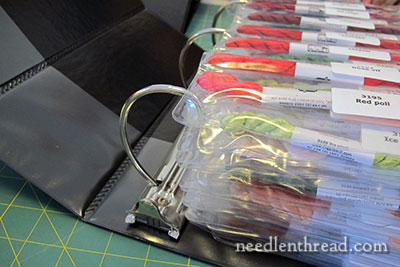
I also mentioned earlier how this particular complete set of Silk Mill silk threads is organized.
With the threads already in their plastic sleeves (which are part of the DMC stitch bow thread organization system), my task was to arrange the threads into binders.
When 4″ binders went on sale (and I had a coupon to boot!), I purchased three of them. I hesitated and almost bought four, but three worked out just fine.
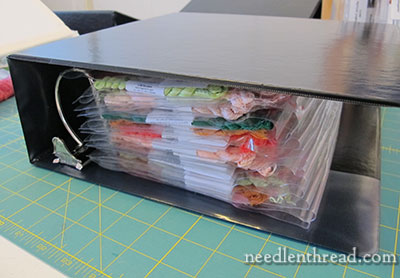
I chose 4″ binders in black, with D rings – the rings that are round on one side and flat on the other – because these rings make it much easier to store a lot of stuff in the binder and still turn the pages easily.
I was able to fit 13 of the Stitch Bow pages (each having slots for 15 skeins of embroidery thread) in each binder. So, each binder holds 195 skeins.
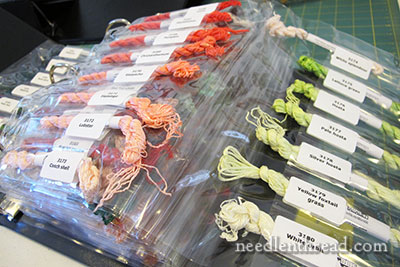
The “pages” of these thread books unfold to reveal all 15 skeins, and I’ve arranged the pages in order, according to their thread numbers, which also conveniently organizes them into shade families within specific colors. The colors are not grouped together, though, in each binder. They progress according to the numbers they were assigned when they came to market.
So, in one binder, I might have a family of coral reds in graduated shades, along with pale greens in graduated shades, yellows, tans, blues and so forth, and in another binder, other families of reds (pinky reds) might reside with all the shades in the pinky red family, along with a blue-green family, and so forth.
The point is, they’re arranged by number, and within a number range, there is a group of shades of a given color family.
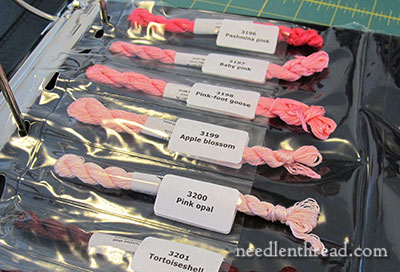
This is my kind of Picture Book! I could browse through the pages of these three books all the day long! There are so many gorgeous colors and shades in the The Silk Mill thread line!
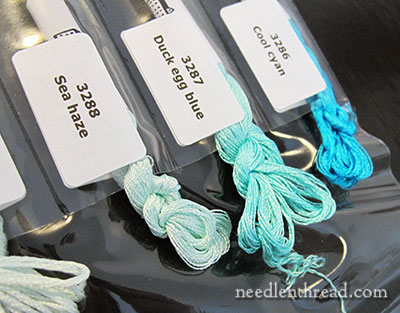
*Sigh*
Monitors and cameras in various lighting situations don’t always do colors justice. But I think you can understand why I sigh. I’m sure there’s an ocean shore out there waiting for me, in just those colors.
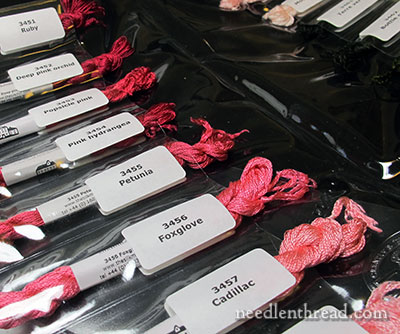
I love the arrangement of shades here. It’s often difficult to find a red line with enough deep-to-light shading in it. Just think of the needlepainting possibilities!
Yep. This is much better than thumbing through a picture book.
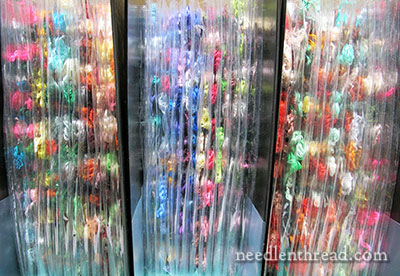
And this is better than a jar of candy!
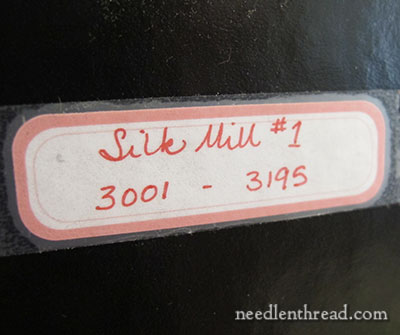
I labeled each binder 1 – 3, with the number range within that particular binder. Now I can find the threads by number easily, or I can flip through and look for specific colors.
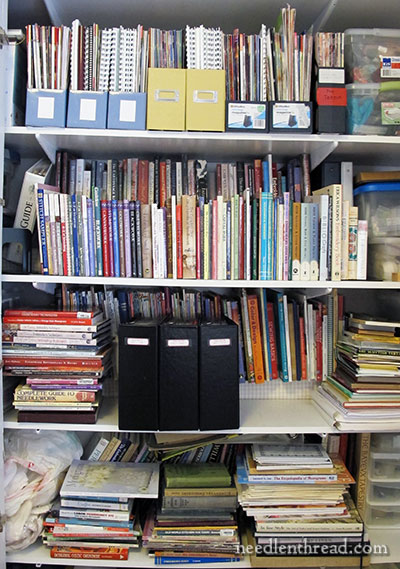
The binders were then situated on the front of one of my book shelves (which are very deep and accommodate a couple layers of books, as you can see).
And then, I did what any self-respecting person would do…
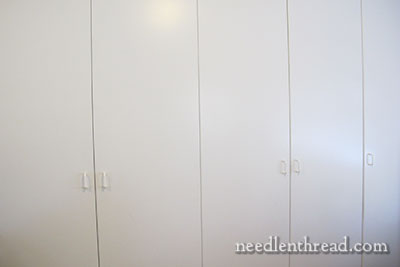
…I shut the cabinet doors.
I used to store all my books on open book shelves, but dust and bookshelves have an affinity for each other, and I got sick of dusting them. So I keep all my books inside a closed cabinet. In fact, I keep all my “stuff” relating to embroidery in these cabinets, which are floor-to-ceiling, with doors that close, so that the possibility of dust and light is at least reduced. And it keeps the work room looking somewhat orderly, with all the stored stuff behind closed doors.
Somewhat is the operative word.
And so, those threads now have a permanent home. They won’t stay in it for too long, though. I’ll be playing with them soon, and you can come along with me and play, too!







Wow! Looks so gorgeous! If only….. *Sigh*
I love your comment about ‘better than a picture book!’ I agree, I could look at those luscious colours all day! The threads may be worn out from me touching them long before they ever reached the fabric!
Gorgeous colors! Can’t wait to see what you do with them.
Those binders of silks are even better than a new box of crayons! The really big box.
I know you’ve done a post or 2 or 3 on your workroom, but I don’t recall that you’ve ever posted about how your big cabinets are organized inside. Did I miss it? What do you use to elevate the back row of books?
They’re not organized in any special way, really! I try to keep the same type of stuff in the same general area, but that’s about as far as it goes…
I am curious as to what form of anti-gravity you have found for the books behind the silk thread binders. They don’t really look like they are hanging from the shelf above, but they certainly are not sitting on the shelf that the binders are! Is there are narrow shelf that raises them high enough to identify things without having to move the binders? Just curious, as I am always looking for ways to fit more stuff into my available space.
I have a small makeshift shelf that’s about 6″ deep on the back of the main shelf (it’s covered in tan gingham – you can see it just to the right of the binders, and under the books). There’s one on the shelf above, too. The problem with the shelves in these cabinets (at least as far as book storage goes) is that they are very deep. One layer of books leaves a lot of empty space on the shelf, so I just put together some makeshift shelves that are six inches deep and about four inches high, I think, and put those on the back of the shelf, so that I could have two layers of books on each shelf, one in front of the other. It’s not the most convenient way to store books, but it does give me a lot of book space on fewer shelves.
That is a great storage system. I currently store my floss wound on those tiny , numbered cards, but since I am thinking of asking for thread sets for my birthday and Mother’s Day, the binders make more sense. I also admire your cabinets!
I thought to check past posts, there are a couple of photos inside one cabinet in a September 2011 post. It looks like this photo and that one may even be the same set of doors (mostly books). Is there any chance of seeing inside more of them?
They really just have bins and boxes and bags and so forth stacked in them. They all look the same, just different stuff, and not always particularly organized, though I do try to keep the same types of stuff in the same areas.
Hi Mary,
I have a question. The binder system looks great. But what do you do with small left over pieces of silk thread? I always seem to have small lengths of perfectly good thread left over. I don’t want to throw them away. At the moment I am using the small zip bags that fit on rings. Because they are bulky I keep them in a special tote bag .
Barbara La Belle
If it’s not enough to keep in the shape of a skein, I put them in small bags. I don’t store most of my thread this way, in the binders – most of my thread is in drawers. The binders are just for this particular set of threads, because that’s how the set was organized and sent to me. It’s my “reference” set, for selecting colors. I either order the thread I need after referring to the threads in the binders, or I use skeins from the binder and order replacements for them right away, to make sure I always have a complete “reference” set.
Oh, and March 2008 when your hobby room was just renovated and you just started putting things on the shelves has a couple of photos.
In case you haven’t guessed, my sewing/hobby/office room is a Horrendous Mess, and I’m looking for inspiration to get in there and clean up (and out).
Mary, this worked wonderfully.
I have a couple of questions. For long-term storage, is there any issue with off-gassing from the plastic? Has it changed and now can be used without worries?
I am positive you go through more thread in a year than hobbyists will in a decade. I have a fairly extensive collection myself that’s spanned quite a few years, but make sure to open it up and move it about and check for visitors (yarn has a corresponding four letter word that is checked more frequently) if it’s been a while. Hazards of not being devoted to one discipline. Frustrated with the dearth of storage management for silk ribbon, I bought acid free card stock and made my own spools.
Another question; if you bought the cabinets, would you mind saying from whom? I would love to find something like them. Deep storage is a feature I find very useful.
Thanks for running such an informative site.
Hi, Susan – Well, I think the thread would have to be in there for a long time, to be affected by the plastic. My thread gets used pretty frequently, and I move it around, take it out, try it for this or that. So I’m not too worried about the plastic storage for this. Also, my workroom is climate controlled, so humidity (or at least, extended humidity) is not a problem. I think if I lived in a humid climate (which I do, sometimes!) and I didn’t have AC, I’d be more inclined to avoid this kind of plastic storage, because I’d be more worried about the moisture that could build up inside the plastic.
My workroom used to be a single car garage. The cabinets were built as part of the room, when the garage was overhauled into a workroom. It was a matter of explaining to the remodeler what was wanted, rather than purchasing something ready made. The shelving system he set up inside the cabinets is pretty much your basic adjustable bracket shelving. I’m not exactly sure the shelves were meant to hold this much weight in books, but they’re holding up ok – just a little bowing in the book section, but nothing too bad!
Commenting again because I forgot to check the notification box.
I have 2 questions for you. 🙂 One I’ve had for awhile now. This is “the” moment to ask. (Talking about thread organization) LOL.
1. WHERE did you find those huge, lovely binders? I have mine in little 3-ringers, this would be wonderful. I could get everything into one! (I don’t have your wealth!)
2. When you are finished with a project, I am assuming that you have the same thing I have- threads partially used. Cut in lengths with 4, or 2, or even 1 thread of the 6 remaining. HOW do you organize them? I have the remainders of 2 pieces still hanging on my thread holder (homemade) waiting for me to figure this out! I MUST come up with something soon or it will be a TANGLE. Literally and figuratively. HELP!
HI, Carol – The binders for this thread set are for a “reference” set – I won’t actually use these threads and then re-store them in the binder. If I need to use a skein, I’ll replace it with a new skein, because, to design anything with a certain type of threads, it’s really handy to have the real threads for color reference, and that’s what this set is for.
Most of my threads are stored in flat file cabinets, which I’ve written about here: https://needlenthread.wpengine.com/2012/04/embroidery-thread-storage.html When I have extra threads already cut, or the skein has dwindled to the point that it doesn’t hold its number tag anymore, I usually use a small ziplock (2″x3″).
Oh, does this ever warm the cockles of my little OCD heart!!! Love, love the organizing and seeing all those skeins of thread all tucked into their little pouches, just waiting to be pulled out and sewn into something beautiful and creative! Sigh. Now seriously, Mary, you’ve got a problem here. We may have to do some intervention with you. (lol — just kidding)
Oh, no. Trust me! I’d like to be even just a little obsessive about organizing – enough that I’d actually be an organized person. I’m just a “functionally organized person” – just enough organization to be able to function. Actually, if you could see my desk right now, that would even be debatable…
I use mostly naturally dyed stuff, so my colour ranges are narrowed to what was in my last few dyebaths, it makes organisation much simpler.
Dear Mary
When you wrote about these plastic sleeves a short time ago I bought 10 plastic sleeves which hold 15 skeins of thread and the DMC binder from Sew and So here in the Uk, I was able accommodate most of my threads in the plastic sleeves. This is a great way of storing threads in a small space and I love that all my usable threads are in one place and I can browse through the sleeves for colour combination, like you I’ve filed them in colour sequence for easy access of the different thread families. I love them. Thanks for the tips on how to organise thread.
Regards Anita Simmance
Mary, Where did you find such large binders? I can’t find anything nearly that large?
Oh, sorry – I think I missed that question earlier. They have them at office supply stores. I got mine at Office Depot. They’re pretty expensive, the larger they get, but if you wait for a sale or a coupon, it helps!
Thanks so much Mary. I will go and look. 1 large one I think might be easier than several little ones…
Another suggestion for purchase would be shopping the large warehouse stores like Costco. They have bundled packs of the large 3 ring D-slant binders, often packaged as 2 or 3 for the price of one purchased from the office supply stores. The ones I found were heavy duty, and should hold up well. The colors might be more limited than the office supply stores.
Closing cabinets to keep out dust and sun is brilliant! Less work dusting more time for other things. You have loads of good ideas Mary.
Hi Mary,
I have a dumb question! How did you get the skeins in the sleeves with out them getting ” squished”? They look great by the way
Well, they actually came from the Silk Mill that way, already organized in the sleeves. But I’ve taken some out and put them back in, and I use one of the handiest tools in my whole tool arsenal to do the job. It’s a chopstick. I use chopsticks a lot – I have a couple old, beautiful chopsticks that I keep out in the workroom for all kinds of little tasks, and they come in really handy! So I just use a chopstick to push the skein in, pushing on the end of the skein that’s farthest into the sleeve. They go in nice and neatly that way. ~MC
I was drooling over all the colours, Mary! ( Oh sorry about the spelling! I mean color!) Those blues! Just right for an E John Robinson painting! I wonder if there’s a name for what we’ve got/ Colouritis? Chromatisism?
Hi Mary,
I just discovered your blog and I am WOWed by it! Your videos are outstanding!
I have taken up embroidery/crewel again after a hiatus of several years and was rusty with my stitches. Then, after a quick Google search for help, you came to the rescue! Also, you showed me –from your long/short stitch video– exactly what that stitch is used for, something I didn’t know though I have used it. Your video will help me do a much better job now.
Thank you so much for all you do. I hope to be able to afford to buy some of your products in the future.
Val
Hi, Val! Thanks for your note and welcome aboard! I’m glad you find the videos useful. If you ever come across a stitch you’d like to see worked out, just drop me a line. I’m always open for suggestions! ~MC
Hi Mary!
I learn so much from your postings!! Love (and a bit envious of) your silk threads!
I went back and read about the cabinets, and I’m thinking for me that might be the way to go. But, I have a couple of questions about them.
1. You mention they go on sale once a year. Do you know what time of the year that is?
2. The DMC floss that you have in the drawers looks like you have them grouped by color families. I think I would want them in #order or else I would go crazy trying to find the right one the pattern calls for. Any idea on what might work for that?
Thanks again for your great, informative posts! I read daily:)
Hugs,
Gina
Hi, Gina – 1. They ran the sale in February, so I think it’ll be a year before they do it again. :-/ I signed up for their newsletter, so that’s how I get the notification. 2. The DMC threads are grouped by color, but my Au Ver a Soie threads (Soie d’Alger, etc.) are arranged by number. You can’t fill the drawer as full when they’re arranged by number – I have them in one layer inside the flat drawers. You’d be surprised how easy it is to find a color by number, though, when they’re grouped in a color family. You do have to rummage a bit, true, but it isn’t too difficult. I keep a checklist of the thread numbers, and if I pull a number out of a drawer for a project, I tick it off on the checklist, so that I know I need to replace it. ~MC
A small request, Mary. A teeny tweeny one. Could I please have the entire contents of those bookshelves you show in that photo?
LOL
All the best
Following your first review of these threads I bought a handful – a small handful – to try out, something I am yet to do. But they do look and feel luscious. I wish I could afford to do what you have: sadly the exchequer is not that voluminous just now (and with the threatened Budget coming up next week, heaven only knows where we will be, financially and physically). Maybe one day…..